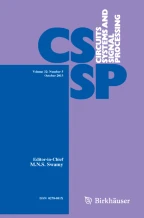Abstract
In this paper, we present an underdetermined estimation algorithm for two-dimensional (2-D) direction of arrival (DOA) based on three-parallel co-prime arrays. By exploiting the correlation among the received signals in both the time and spatial domains, a conjugate augmented spatial–temporal virtual array is constructed, which significantly increases the degrees of freedom (DOF) and expands the array aperture, effectively filling the holes within the physical array. By vectorizing the covariance matrix obtained from the spatial–temporal virtual array, we can transform the 2-D DOA estimation problem into a one-dimensional (1-D) sparse recovery problem. Thereafter, the excellent gridless methods: sparse and parametric approach (SPA) and the matrix pencil and pairing (MAPP), are adopted to efficiently resolve the 1-D sparse recovery problem, enabling the automatic pairing of the 2-D angles. And simulation results are provided to validate the enhanced accuracy of the proposed algorithm in comparison with other existing methods.
Similar content being viewed by others
Data availability
The data included in this study may be available upon reasonable request by contacting with the corresponding author.
References
H. Chen, C. Hou, Q. Wang, L. Huang, W. Yan, L. Pu, Improved azimuth/elevation angle estimation algorithm for three-parallel uniform linear arrays. IEEE Antennas Wirel. Propag. Lett. 14, 329–332 (2015). https://doi.org/10.1109/LAWP.2014.2360419
H. Chen, W. Wang, W. Liu, Y. Tian, G. Wang, An exact near-field model based localization for bistatic MIMO radar With COLD arrays. IEEE Trans. Veh. Technol. 72(12), 16021–16030 (2023). https://doi.org/10.1109/TVT.2023.3294625
P. Gong, X. Zhang, J. Shi, W. Zheng, Three-parallel co-prime array configuration for two-dimensional DOA estimation. in 2017 9th International Conference on Wireless Communications and Signal Processing (WCSP), pp. 1–5 (2017). https://doi.org/10.1109/WCSP.2017.8171003
Y. Hua, T. Sarkar, Matrix pencil method for estimating parameters of exponentially damped/undamped sinusoids in noise. IEEE Trans. Acoust. Speech Sign. Process. 38(5), 814–824 (1990). https://doi.org/10.1109/29.56027
J. Li, P. Li, P. Li, L. Tang, X. Zhang, Q. Wu, Self-position awareness based on cascade direct localization over multiple source data. IEEE Trans. Intell. Transp. Syst. (2022). https://doi.org/10.1109/TITS.2022.3170465
M. Li, C. Zhang, Improved nested Array DOA estimation based on sum difference virtual array. in 2023 8th International Conference on Intelligent Computing and Signal Processing (ICSP), pp 2133–2137 (2023). https://doi.org/10.1109/ICSP58490.2023.10248579
Y. Liao, Y. Lin, R. Zhao, 2D-DOA estimation using L-shaped distributed augmented nested array. in 2021 13th International Conference on Wireless Communications and Signal Processing (WCSP), pp. 1–7 (2021). https://doi.org/10.1109/WCSP52459.2021.9613225
P. Ma, J. Li, J. Pan, X. Zhang, A novel spatial sampling scheme for DOA estimation with movable arbitrary sparse arrays. IEEE Sens. J. 22(11), 10974–10985 (2022). https://doi.org/10.1109/JSEN.2022.3168739
S. Marcos, A. Marsal, M. Benidir, The propagator method for source bearing estimation. Sign. Process. 42(2), 121–138 (1995). https://doi.org/10.1016/0165-1684(94)00122-G
S. Nannuru, P. Gerstoft, A. Koochakzadeh, P. Pal, Sparse bayesian learning for DOA estimation using co-prime and nested arrays. in 2018 IEEE 10th Sensor Array and Multichannel Signal Processing Workshop (SAM), pp. 519–523 (2018). https://doi.org/10.1109/SAM.2018.8448773
Z. Peng, W. Si, F. Zeng, 2-D DOA estimation for L-shaped sparse array via joint use of spatial and temporal information. IEEE Commun. Lett. 24(9), 1934–1938 (2020). https://doi.org/10.1109/LCOMM.2020.2998529
R. Schmidt, Multiple emitter location and signal parameter estimation. IEEE Trans. Antennas Propag. 34(3), 276–280 (1986). https://doi.org/10.1109/TAP.1986.1143830
J. Shi, G. Hu, X. Zhang, P. Gong, Sum and difference coarrays based 2-D DOA estimation with co-prime parallel arrays. in 2017 9th International Conference on Wireless Communications and Signal Processing (WCSP), pp. 1–4 (2017). https://doi.org/10.1109/WCSP.2017.8171037
J. Shi, F. Wen, T. Liu, Nested MIMO radar: coarrays, tensor modeling, and angle estimation. IEEE Trans. Aerosp. Electron. Syst. 57(1), 573–585 (2021). https://doi.org/10.1109/TAES.2020.3034012
P. Stoica, P. Babu, SPICE and LIKES: two hyperparameter-free methods for sparse-parameter estimation. Sign. Process. 92(7), 1580–1590 (2012). https://doi.org/10.1016/j.sigpro.2011.11.010
P. Stoica, P. Babu, J. Li, SPICE: a sparse covariance-based estimation method for array processing. IEEE Trans. Sign. Process. 59(2), 629–638 (2011). https://doi.org/10.1109/TSP.2010.2090525
F. Sun, S. Ouyang, P. Lan, F. Li, Reduced dimensional 2-D DOA estimation via least partial search with automatic pairing for parallel co-prime arrays. in 2020 IEEE 11th Sensor Array and Multichannel Signal Processing Workshop (SAM), pp. 1–5 (2020). https://doi.org/10.1109/SAM48682.2020.9104401
N. Tayem, H.M. Kwon, Azimuth and elevation angle estimation with no failure and no eigen decomposition. Sign. Process. 86(1), 8–16 (2006). https://doi.org/10.1016/j.sigpro.2005.05.001
F. Wu, F. Cao, X. Ni, C. Chen, Y. Zhang, J. Xu, L-shaped sparse array structure for 2-D DOA estimation. IEEE Access 8, 140030–140037 (2020). https://doi.org/10.1109/ACCESS.2020.3012685
Z. Yang, L. Xie, C. Zhang, A discretization-free sparse and parametric approach for linear array signal processing. IEEE Trans. Sign. Process. 62(19), 4959–4973 (2014). https://doi.org/10.1109/TSP.2014.2339792
Y. Zhang, X. Xu, Y.A. Sheikh, Z. Ye, A rank-reduction based 2-D DOA estimation algorithm for three parallel uniform linear arrays. Sign. Process. 120, 305–310 (2016). https://doi.org/10.1016/j.sigpro.2015.09.019
Z. Zhang, F. Wen, J. Shi, J. He, T.K. Truong, 2D-DOA estimation for coherent signals via a polarized uniform rectangular array. IEEE Sign. Process. Lett. 30, 893–897 (2023). https://doi.org/10.1109/LSP.2023.3296038
Z. Zheng, S. Mu, Two-dimensional DOA estimation using two parallel nested arrays. IEEE Commun. Lett. 24(3), 568–571 (2020). https://doi.org/10.1109/LCOMM.2019.2958903
Acknowledgements
This research was supported by the Zhejiang Provincial Natural Science Foundation of China under Grants No. LY23F010003, the National Natural Science Foundation of China under Grant 62001256, the Science and Technology Innovation 2025 Major Project of Ningbo City under Grant 2022Z207 and the Student Research and Innovation Program (SRIP) of Ningbo University under Grant No. 2023SRIP1317.
Author information
Authors and Affiliations
Corresponding authors
Ethics declarations
Conflict of interest
The authors declare that they have no conflict of interest.
Additional information
Publisher's Note
Springer Nature remains neutral with regard to jurisdictional claims in published maps and institutional affiliations.
Rights and permissions
Springer Nature or its licensor (e.g. a society or other partner) holds exclusive rights to this article under a publishing agreement with the author(s) or other rightsholder(s); author self-archiving of the accepted manuscript version of this article is solely governed by the terms of such publishing agreement and applicable law.
About this article
Cite this article
Yu, Z., Liu, W., Chen, H. et al. 2-D DOA Estimation Algorithm for Three-Parallel Co-prime Arrays via Spatial–Temporal Processing. Circuits Syst Signal Process 43, 3996–4009 (2024). https://doi.org/10.1007/s00034-024-02629-x
Received:
Revised:
Accepted:
Published:
Issue Date:
DOI: https://doi.org/10.1007/s00034-024-02629-x
